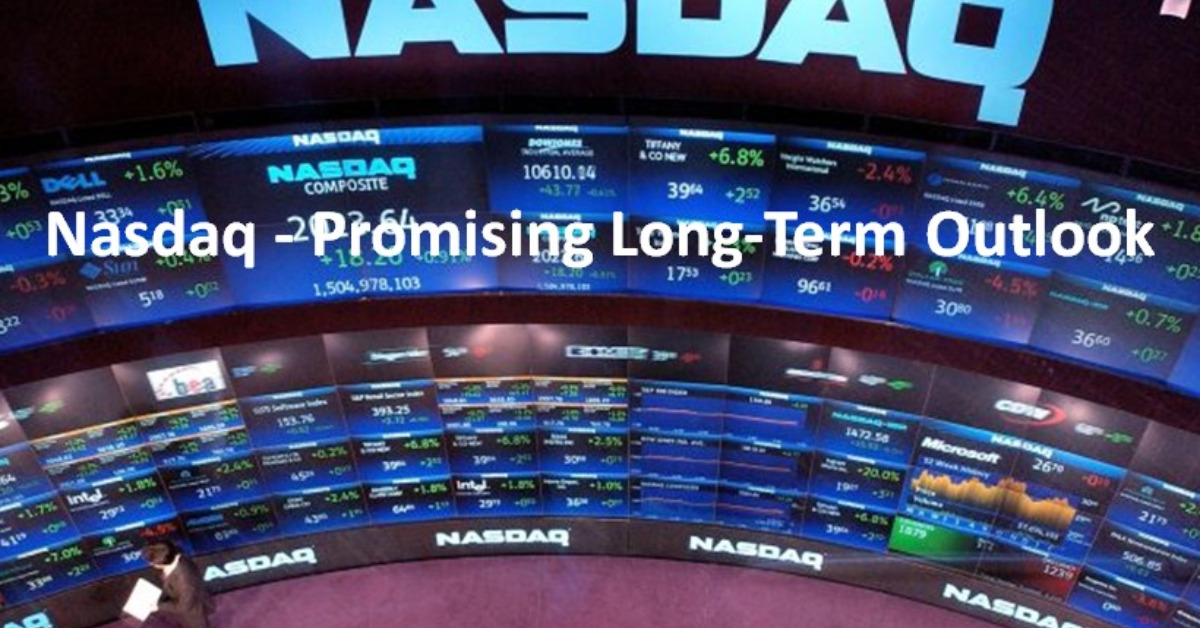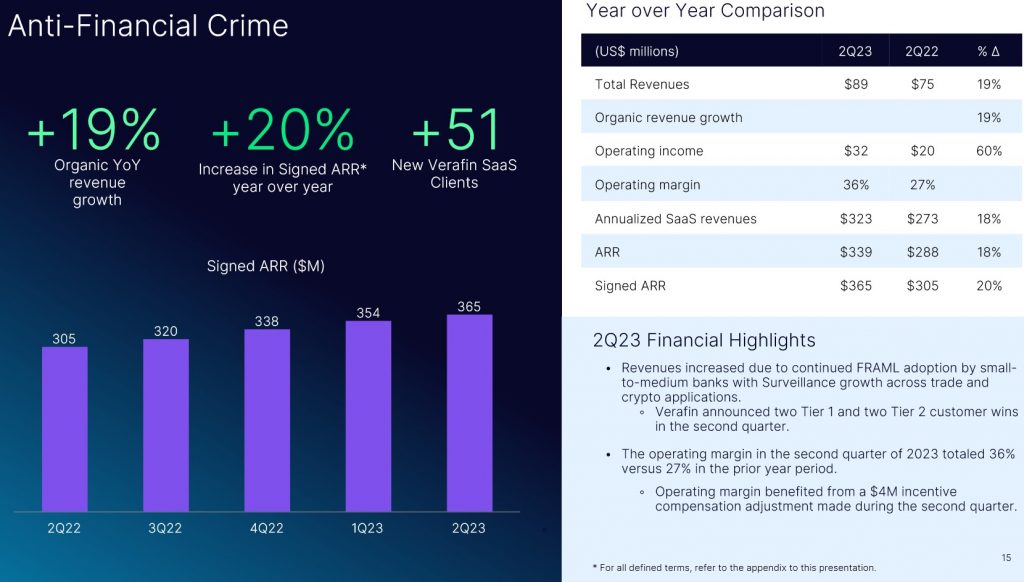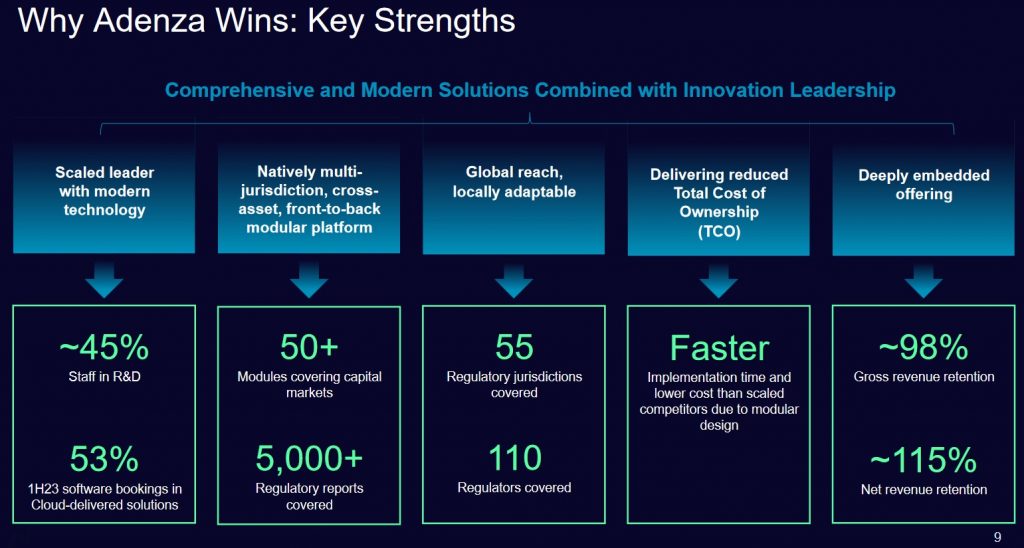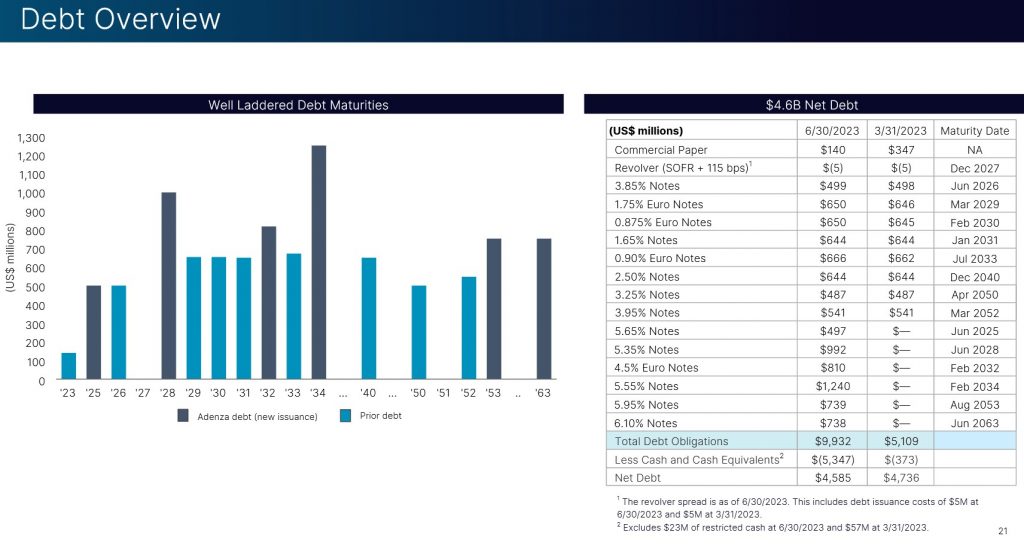Contents

In my June 13 post, I touch upon Nasdaq, Inc.'s (NDAQ) June 12 announcement regarding its definitive agreement to acquire Adenza from Thoma Bravo for $10.5B in cash and shares of common stock; Adenza provides mission-critical risk management and regulatory software to the financial services industry. The rationale for the acquisition is to accelerate NDAQ's strategic vision to become a leading technology provider to the global financial system.
In that post, I conclude that while Adenza is an expensive acquisition, I like NDAQ's long-term strategy. Using the weakness in NDAQ's valuation, I initiated a 500-share position in a 'Core' account within the FFJ Portfolio on June 12 at ~$51/share.
With the release of NDAQ's Q2 and YTD2023 results on July 19, I now revisit NDAQ to determine if I should add to my exposure.
Business Overview
I encourage you to read Part 1 Item 1 - Business in NDAQ's FY2022 Form 10-K.
Adenza Acquisition
Rationale For Acquisition
NDAQ provided an Adenza-related presentation on June 12 when it announced its intent to acquire the company.
Expectations are for this transaction to close within 5 - 8 months, subject to regulatory approval and customary closing conditions.
At closing, NDAQ will issue the shares to Thoma Bravo thus resulting in Thoma Bravo owning ~14.9% of the outstanding NDAQ shares.
On July 19, NDAQ provided additional information as it relates to the impending acquisition.
The financial industry participants face a steady stream of new regulations and reforms which present reputational and financial risk. With the addition of Adenza, NDAQ positions itself to be a key partner in helping participants manage those risks.
NDAQ will enable its clients to meet regulatory mandates to:
- reduce financial crime;
- manage liquidity risk; and
- provide resilient capital markets infrastructure
while reporting on their compliance to over 100 regulators and agencies globally. In essence, the addition of Adenza's capabilities to the NDAQ platform will increase the serviceable addressable market by ~40%.
In the first half of 2023, Adenza maintained strong Annualized Recurring Revenue ('ARR') growth in the high teens as compared to the first half of FY2022. This growth was underpinned by continued strength in gross and net revenue retention at 98% and 115%, respectively.
The fundamental drivers of growth in Adenza's business come from new client sales, cross-sells, and up-sells to existing clients. Consistent with its strong performance in signing new clients over the last two years, both Calypso and AxiomSL continued to demonstrate strong growth which validates NDAQ's acquisition thesis.
During 2021 - 2022:
- Calypso added 37 new logos, with upsells to 160 clients
- AxiomSL added 27 logos, with upsells to 117 clients
During the first half of FY2023:
- Calypso signed 7 new clients and completed upsells to 40 existing clients
- AxiomSL added 7 new logos, 2 of which were cross-sold to Calypso clients, with upsells to 25 existing clients
NOTE: Historically, Adenza sales cycles seasonally skew towards the second half of the year, accounting for ~60% of full-year bookings.
Acquisition Financing
Following the closing of this transaction, management anticipates NDAQ's leverage will increase to ~4.7X Gross Debt / Non-GAAP EBITDA. Although this level is high, NDAQ has demonstrated its ability to reduce leverage following prior acquisitions; management is committed to reducing leverage to 4.0x and 3.3x in 18 and 36 months, respectively.
NDAQ will issue 85.6 million common shares. The value of the common stock is to be based on the volume-weighted average price per share over 15 consecutive trading days before signing the agreement.
It has also issued $4.25B in US dollar-denominated debt across 2,5, 10, 30, and 40-year terms and EUR 0.75B euro-denominated 8-year bonds. Furthermore, to aid it in managing its deleveraging plan, funding of the remainder of the cash component of the transaction will be with commercial paper and the issuance of a $0.6B term loan just before closing; the estimation is a weighted average cost of debt just under 5.5%.
To minimize the carrying cost of the debt before closing, NDAQ is investing the proceeds of the bond issuances in highly liquid and low-risk investments. Expectations are that the net carrying costs will be less than 50 bps at current market rates; this cost will be excluded from NDAQ's non-GAAP results.
The following is a high-level overview of NDAQ's debt and includes the recently issued debt for the Adenza acquisition.
Crypto Custody Service
In September 2022, NDAQ announced that it was putting together the infrastructure and regulatory approval needed for a crypto custody service. It had applied to the New York Department of Financial Services (NYDFS) for a limited-purpose trust company which would oversee the custody business.
However, NDAQ has recently announced that due to the shifting business and regulatory environment in the US, a decision has been made to halt the launch of the US digital asset custodian business, and all related efforts to pursue a relevant license.
What prompted this pullback is a widening crackdown by regulators that aims to isolate crypto’s risks from the US financial system. Banks have been warned about their exposure to crypto businesses, and the US Securities and Exchange Commission (SEC) has filed a series of lawsuits against some of the industry’s biggest firms, including Binance and Coinbase Global Inc.
The decision to halt the US custody business will have a modest financial impact by contributing to a decrease in NDAQ's FY2023 expense growth guidance (see FY2023 Guidance section below).
Despite this recent decision, NDAQ will continue to build and deliver technology capabilities that position it as a leading digital asset software solutions provider to the broader global industry. This includes advancing the custody solution as a technology platform to serve the broader global digital assets marketplace.
CEO and NEO Compensation
Please refer to my June 13 post for commentary regarding this topic.
Financials
Q2 and YTD 2023 Results
The Q2 and YTD2023 results released on July 19, 2023 are accessible here.
Although EPS fell to $0.54 from $0.62 in Q2 2022, this decline is primarily driven by $57 million in merger and restructuring charges.

Source: NDAQ Q2 2023 Earnings Presentation - July 19, 2023

Source: NDAQ Q2 2023 Earnings Presentation - July 19, 2023
In Q2, NDAQ's anti-financial-crime segment produced another quarter of strong performance; the company's underlying strategy for the segment appears to be working.

Source: NDAQ Q2 2023 Earnings Presentation - July 19, 2023
In February 2021, completed its ~$2.75B acquisition of Verafin, an industry pioneer in anti-financial crime management solutions. The purpose of this acquisition was to accelerate NDAQ's ongoing evolution into a leading SaaS technology provider and to significantly strengthen its existing regulatory and anti-financial crime solutions. With this acquisition, NDAQ plans to expand Verafin’s capabilities to service global Tier-1 and Tier-2 banks and broker-dealers; many of these firms were already leveraging NDAQ's technology to detect market manipulation and abuse.
In Q2, NDAQ signed four Tier 1 and Tier 2 bank clients. Four new clients may not seem significant. However, the sales cycle for larger clients is lengthy. Success breeds success and I anticipate the signing of new clients will accelerate once NDAQ's prospects observe the frequency in which Verafin helps its clients strengthen their regulatory and anti-financial crime solutions.
Debt increased by $4.823B versus Q1 2023. This was due primarily to $5.016B net debt issued for Adenza financing, a $13 million increase in Euro bonds book values caused by a stronger Euro. This was partially offset by a net paydown of $0.207B of commercial paper.
Free Cash Flow (FCF)
Various investor platforms reflect NDAQ's FY2013 - FY2022 FCF as being (in millions of $) 459, 492, 594, 642, 765, 917, 836, 1,064, 920, and 1,554. YTD2023 FCF is 900.
NDAQ, however, also calculates its FCF by taking into consideration a couple of additional items (see below). As a result, NDAQ considers its FCF in recent years to be different.

Source: NDAQ Q2 2023 Earnings Presentation - July 19, 2023
In FY2022, it returned ~$0.38B in dividends which was 26% of FCF. It also expended ~$0.23B to offset employee-related dilution. That left it with ~$0.8B in FCF to use for other strategic and investor return activities.
Expectations are for Adenza to generate ~$0.3B in unlevered pre-tax cash flow in the first year following the acquisition. The debt financing for the Adenza acquisition, however, is likely to result in an annual interest payment of ~$0.325B which is more than Adenza’s current free-cash flow. However, as Adenza grows and debt is reduced, NDAQ expects incremental FCF from the addition of Adenza to fund incremental debt repayment and share buybacks; management expects ~$0.7B in excess annual FCF beyond the dividends and employee-related buybacks. This amount is expected to grow commensurately with earnings growth over the next few years.
FY2023 Guidance
NDAQ has narrowed its 2023 non-GAAP operating expense guidance by $30 million to $1.785B - $1.815B. The midpoint of the expense guidance range represents an annual expense increase of just below 5% for 2023. The decrease in expense growth expectations primarily reflects the impact of the decision related to the redesign of NDAQ's digital assets offering as well as the adjustment to the incentive compensation program.
Assuming stable performance and exchange rates, expectations are for 2023 expenses to be near the middle of the updated guidance range. Additionally, due to the timing of expected expenses, it is expected that there will be a greater sequential increase in expenses in Q3 than in Q4.
The FY2023 non-GAAP tax rate is expected to be 24% - 26%.
Credit Ratings
Immediately upon announcing the Adenza acquisition, NDAQ's domestic unsecured long-term debt was downgraded from Baa1 to Baa2 by Moody's and from BBB+ to BBB by S&P Global. These new ratings are the middle tier of the lower medium grade investment grade category. They define NDAQ as having an adequate capacity to meet its financial commitments. However, adverse economic conditions or changing circumstances are more likely to lead to a weakened capacity for NDAQ to meet its financial commitments.
Despite the ratings downgrades, NDAQ has demonstrated its ability to reduce leverage within a reasonable timeframe following major acquisitions. Upon closing the Adenza acquisition, NDAQ's capital allocation priority over the next 3 years will be to reduce Gross Debt / Non-GAAP EBITDA to 4.0x in 18 months and to 3.3x in 36 months.
I am prepared to give management the benefit of the doubt that it can replicate what it did following the two most recent large transactions despite a higher cost of capital environment than in 2017 and 2021.
Dividend and Dividend Yield
NDAQ's dividend history is accessible here.
In Q2 2023, NDAQ returned $0.109B of cash to shareholders through the distribution of dividends.
My interest in NDAQ lies in its potential long-term TOTAL investment return. Its dividend metrics do not factor into my investment decision-making process.
On July 19, NDAQ declared its second consecutive regular quarterly dividend of $0.22/share on the company's outstanding common stock. The dividend is payable on September 29 to shareholders of record at the close of business on September 15.
Using my ~$50.75 purchase price on July 19, the dividend yield is ~1.7%.
With the issuance of shares to acquire Adenza, if all else stays the same, the dividend payment at the current payout of $0.22/share will increase to ~$0.51B annually.
NDAQ plans to increase the dividend to achieve a 35% - 38% payout ratio over the next 3 or 4 years; this implies a ~10% CAGR in the dividend payout ratio over this timeframe. Calculation of this payout ratio annualizes the last paid quarterly dividend divided by the last 12 months of non-GAAP net income.
The weighted average number of shares outstanding in FY2013 - FY2022 (in millions of shares) is 514, 519, 514, 506, 509, 503, 501, 501, 505, and 498. For Q2 2023, this was 493.6.
As of June 30, 2023, there was $0.491B remaining under the Board authorized share repurchase program.
NDAQ's weighted average shares outstanding will surge once it issues 85.6 million common shares to Thoma Bravo. However, NDAQ expects to partially offset deal dilution with additional buybacks. In addition, it will continue to repurchase shares to offset employee stock compensation.
After NDAQ's leverage reaches target levels, the focus will be on using the vast majority of remaining FCF to execute share buybacks. Management states it does not anticipate making any significant acquisition-related capital allocation decisions that would deter the company from sizable stock buybacks over the coming years.
Stock Splits
NDAQ initiated a 3 for 1 stock split in 2022.
Valuation
In FY2013 - FY2022, NDAQ generated diluted EPS of $0.75, $0.80, $0.83, $0.21, $1.43, $0.91, $1.54, $1.86, $2.35, $2.26. Its diluted PE levels were 20.52, 17.70, 27.31, 23.63, 49.57, 18.25, 33.89, 24.31, 30.57, and 26.91.
When I reviewed NDAQ in my July 13 post, the forward-adjusted diluted broker estimates and valuation using my ~$51 purchase price were:
- FY2023 - 14 brokers - mean of $2.72 and low/high of $2.60 - $2.84. Using the mean estimate, the forward-adjusted diluted PE is ~18.75.
- FY2024 - 15 brokers - mean of $2.89 and low/high of $2.66 - $3.11. Using the mean estimate, the forward-adjusted diluted PE is ~17.6.
- FY2025 - 8 brokers - mean of $3.06 and low/high of $3.00 - $3.15. Using the mean estimate, the forward-adjusted diluted PE is ~16.7.
Using my most recent ~$50.75 purchase price and the current forward-adjusted diluted broker estimates, NDAQ's valuation is:
- FY2023 - 16 brokers - mean of $2.76 and low/high of $2.60 - $2.84. Using the mean estimate, the forward-adjusted diluted PE is ~18.4.
- FY2024 - 17 brokers - mean of $2.87 and low/high of $2.29 - $3.10. Using the mean estimate, the forward-adjusted diluted PE is ~17.7.
- FY2025 - 11 brokers - mean of $3.14 and low/high of $2.97 - $3.33. Using the mean estimate, the forward-adjusted diluted PE is ~16.2.
In my previous post, I state that Adenza is expected to become accretive to NDAQ's earnings within 2 years. Until such time, NDAQ will be incurring acquisition and integration expenses that will likely exceed incremental earnings. On this basis, I lowered NDAQ's mean FY2024 forward-adjusted diluted estimate by $0.30 to $2.59. Doing this, the forward-adjusted diluted PE then becomes ~20 based on my $51 purchase price. Lowering the mean FY2025 forward-adjusted diluted estimate by $0.15 to $2.91, changed the forward-adjusted diluted PE to ~17.5 based on my $51 purchase price.
If I lower the current forward-adjusted diluted broker estimates by similar amounts and use my recent ~$50.75 purchase price, I get the following:
- FY2024 - $50.75/$2.56 = ~19.8
- FY2025 - $50.75/$3 = ~17
I consider these levels to be acceptable given NDAQ's growth potential.
Final Thoughts
My final thoughts are the same as those in my June 13 post. An investment at the current valuation offers a realistic probability of attractive double-digit total investment returns over the next 5 - 10 years.
On July 19, I increased my exposure by 100 shares at ~$50.75. My NDAQ exposure now rests at 601 shares in a 'Core' account within the FFJ Portfolio; the automatic reinvestment of the June 30 dividend payment is how I obtained 1 additional share.
I wish you much success on your journey to financial freedom!
Note: Please send any feedback, corrections, or questions to [email protected].
Disclosure: I am long NDAQ.
Disclaimer: I do not know your circumstances and do not provide individualized advice or recommendations. I encourage you to make investment decisions by conducting your research and due diligence. Consult your financial advisor about your specific situation.
I wrote this article myself and it expresses my own opinions. I do not receive compensation for it and have no business relationship with any company mentioned in this article.



